Hey Solarpunk Community! In Light Of Several Posts That Have Been Going Around, I Was Thinking It Would
Hey solarpunk community! In light of several posts that have been going around, I was thinking it would be worthwhile to talk about the real, physical things we can do to make this world a more solarpunk place. Because speculation and aesthetics and thinkpieces are awesome, but a movement isn’t a movement without real action behind it. So what are things we can all do to make the present closer to our solarpunk future?
More Posts from Copperfingertips and Others
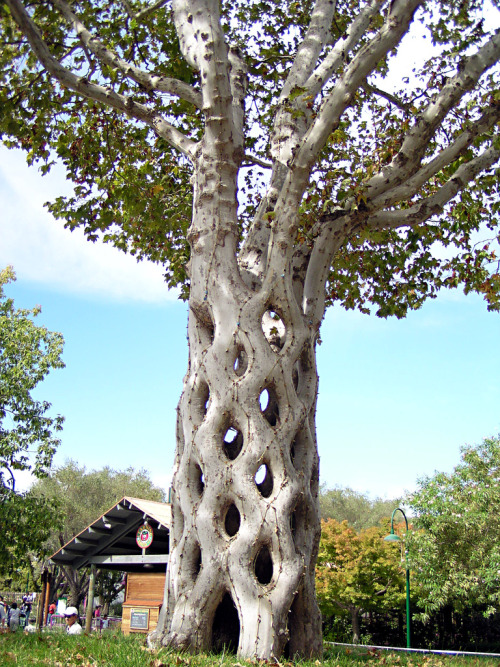
Circus Tree: Six individual sycamore trees were shaped, bent, and braided to form this.
So some dude got sent to the hospital with cyanide poisoning because he was eating cherries and decided, for some fucking reason, to crack the pits open and eat the meat inside.
“I didn’t think nothin’ of it. Thought it was just a seed.”
“Deep breath”
I SWEAR TO THE FUCKIN GODS…..
(cue 25 minutes of unintelligible yelling)
….and that is why being separated from our food’s origins and not knowing anything about botany is what is wrong with the world today goddamnit.

I didn’t do the inktober this year, but I had fun with a tiny house :3
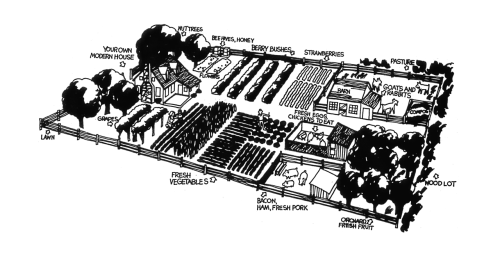
Self Sufficiency, 1970s
Right to Darkness/Right to Night
Human beings have lived with a relatively strict day/night cycle for as far back as humans have been around. Yes, there was fire, but the rooms were still relatively dim, and outside was almost always just lit by the moon. Daily darkness, where not much could get done has been a part of human culture and biology forever.
Now we have the problem of light polution, where the light of electricity spreads everywhere and then you can’t see the stars at night in the cities. Obviously it’s good that we have electric lights. There are many people who want to be out doing things at night. But it’s also a problem, because for most, nightime is a time of calm and processing the day, and it can be difficult for the human brain to know that it’s time for that to happen if it has too much light coming at it.
I think in Solunarpunk societies, people would have a recognized right to darkness/night, that made itself apparent in the design of light sources and buildings, so that anyone who wanted to could enjoy the dark, cool, and quiet regardless of where they live.
This could manifest as rules about how streetlights can be made, so that the designs that are used are the ones that have the least amount of light seepage
Possibly different light zones, so the bars and clubs and other nightime activity stuff is all in one area, so those people can be safely lit, while other neighborhoods have street lights that only come on if someone is walking there, and are as unobtrusive as possible, so that people can stargaze and sleep in peace.
Inside houses, there might be automatic window darkeners that activate whenever you turn on a light, so the outside isn’t affected, that then turn transparent when the light is off for long enough.
Most houses would have smart lighting with a “night mode” that kept the lighting warmer and dimmer. If you had no lights on, red floor lights will turn on if it senses you moving so you can see where you’re going in safety.
Or maybe people just start using their night vision for more things. People just don’t turn on the lights at night if they don’t have to.
I imagine that in a right to night would also mean that it would be expected that work ends at sunset. People are free to pursue their own passions at night, and are free of daytime responsibilities. No one could pressure someone to stay later than they wanted to, but especially after sunset, because that would be extremely rude and people would call them out for it.
Stargazing would become an important family activity. Children would grow up knowing the names of all the constellations they could see, as well as the names of the planets and the stars. A sense of wonder about our universe would begin to arise again in our society.
Any moon bases built in the future would be on the side of the moon that always faces away from us, just in case the light could be seen at night. There would be observation sites on the side facing Earth that are too small to be seen, but are connected to each other underground. These observation sites would be open and available all the time, for anyone to come and marvel at the beauty of our home planet.

Speaking about alternative ways of growing things, have you seen the bottle tower gardens invented by Willem Van Cotthem? His youtube videos are a bit amateurish but the plant results look amazing. I prefer straight up recycling plastic bottles but that IS a neat upcycling idea and it's a water-efficient and space-efficent way of gardening 8D
Oh nice, I hadn’t seen these before, but they look ingenious!

A great way to repurpose waste plastic too, especially as not everywhere has plastic recycling facilities. The water efficient part is appealing too. Solutions like this would be helpful for people living in more arid climates!
Here’s a quick DIY guide for anyone who’s interested.



Yacouba Sawadogo is an exceptional man – he single-handedly managed to solve a crisis that many scientists and development organizations could not. The simple old farmer’s re-forestation and soil conservation techniques are so effective they’ve helped turn the tide in the fight against the desertification of the harsh lands in northern Burkina Faso.
Over-farming, over-grazing and over population have, over the years, resulted in heavy soil erosion and drying in this landlocked West African nation. Although national and international researchers tried to fix the grave situation, it really didn’t really make much of a difference. Until Yacouba decided to take matters into his own hands in 1980.
Yacouba’s methods were so odd that his fellow farmers ridiculed him. But when his techniques successfully regenerated the forest, they were forced to sit up and take notice. Yacouba revived an ancient African farming practice called ‘zai’, which led to forest growth and increased soil quality.
(Fact Source) Follow Ultrafacts for more facts

Tis the season of mass consumption. One of my friends was telling me about how her grandmother used to save old holiday cards to make name tags for presents. Seemed pretty solarpunk to me. Thought I’d share.
Can't afford to buy things for your garden?
*Re-posting, with new information
A store-bought bag of topsoil, a roll of landscaping fabric, or a bag of cedar chips doesn’t go very far if you have a large garden or a very limited budget. Here are some ways to create the materials you need for a beautiful, organic, productive garden, by both re-directing household waste, and foraging in your local area. I use a lot of these tricks in my garden to make it almost completely free for me to continue growing new things, and expanding the workable area every year!
For soil
Save your food scraps to create a rich compost for growing veggies and amending your soil. There are numerous options for every size of dwelling and yard. Small space solutions such as Bokashi and vermicompost work indoors and don’t produce bad smells, so you can keep them underneath the sink.Worm towers, compost heaps, and outdoor compost bins are a great solution if you have more space. The more you add, the more rich, nutritious material you can make for your garden. I like composting because it means I don’t have gross smelly garbage bags to deal with, because food waste is diverted. It seems like a lot of work at first, but it actually saves time, money, and transportation.
Seaweed or kelp is one of the best things for your garden, with over 70 essential nutrients, and acting as a weed barrier and a moisture-retentive mulch. I collect seaweed nearby on the beach with my bike trailer, or, when I go for a walk I bring a little home with me each time. It’s an absolute miracle for your soil.

Worm tower
Fertiliser
There are three things that are essential for plant growth. These are nitrogen for leaves and vegetation (N), phosphorus for roots and shoots (P), and potassium for water movement, flowering, and fruiting (K). Commercial fertilisers will give the relative concentrations of each of these compounds with and “NPK” rating. Plants like tomatoes also need calcium to produce healthy fruit. You can create amendments for your garden and soil at home so that you do not have to purchase fertiliser.
For nitrogen
Grass clippings contain 4% nitrogen, 1% phosphorus, and 2% potassium (NPK = 4-1-2).
Human urine contains 12% nitrogen, and it’s sterile. Dilute before adding directly to plants.
Legumes such as beans, clover, peanuts, and alfalfa fix inorganic nitrogen into the soil with mycorrhizal organisms and nodules on their root systems. Plant these crops every few years in rotation with others to renew the soil organically.
For phosphorus
Human urine is also a great source of phosphorous and trace amounts of potassium.
Ground up bones or shells add a slow-release phosphorous to the soil
Had a baby recently? Bury the placenta in the garden.
For potassium
Hardwood ashes
Composted banana peels
For calcium
Break down all of your eggshells, or seashells you have found, in a plastic bucket, using vinegar. This creates a soluble calcium solution you can add to a watering can.
Soil Acidity/Alkalinity
Many plants are particular about what the soil pH should be.
To make soil more acidic: add oak leaves, pine needles, leaf mulch, urine, coffee grounds or sphagnum.
To make soil more alkaline: add wood ash, shell, or bone.
Mulch
Mulch is decomposing organic matter that adds nutrition to the soil, while simultaneously keeping out weed growth and retaining moisture. It also attracts worms, fungi and other beneficial creatures to your soil. Free sources of mulch include:
Leaves
Garden waste
Grass clippings
Straw (often straw bales are given away after being used for decoration in the fall. You can also plant vegetables directly in straw bales using a technique called straw bale gardening).
Wood chips (if you can borrow a wood chipper after you’ve collected some wood you can have attractive wood mulch for free)

Straw bale garden
Landscaping fabric
When mulch isn’t enough to keep the weeds down, many people opt for landscaping fabric. It can be quite expensive and inorganic-looking. Free solutions that both attract worms and can be replaced in small segments as they break down include:
Newspaper*
Cardboard*
Egg cartons*
Printer paper, looseleaf, etc. in thick layers*
*try to make sure you are using paper that has vegetable-based dyes, so you aren’t leeching toxins into the soil.
Soil density/drainage
If your soil is compacted and you have plants that require low levels of water, or excellent drainage, add sand. I don’t recommend stealing it from the beach, but ask around and you’d be surprised at how easy it is to get for free. Sawdust also improves drainage. Adding organic matter and mulch encourages worms, who also till and aerate compacted soil.
If the area still needs drainage, dig a hole and fill it with bricks or rocks to create a “dry well”
For drainage in pots, add crushed bricks, terra cotta pot fragments, packing peanuts, small stones, marbles, orsand to the bottom under the soil layer. I find these in construction sites, on craigslist, or at flea markets.
Pots and growing containers
If you have space, raised beds are a great no-dig way to establish growing space. If you are pressed for space (like working on a balcony) there are many cheap or free options for container gardens.
Creating raised beds allows you to build up the soil without digging. Free ways to do this include using rocks or lumber (like my DIY “lasagna garden” made with the sheet composting technique), using the “wattle“ method with sticks and posts you have found, using discarded straw bales, old bricks,paving stones, cinder blocks or really anything else you have lying around.
Hugelkutur raised beds, which fix carbon and provide drainage, can be made by stacking sticks and untreated wood, and then piling soil or compost over it. (Thanks milos-garden)
Rubber tire gardens retain heat in the night and allow for great drainage. They can also be painted in fun ways.
Herb spirals (here is mine: 1, 2, 3) can be built with stones, bricks, and other found materials.
I often use old cooking pots, barbecues, teapots, or other found objects as planters.
Making wooden planters is easy, and scrap or salvaged wood is also easy to come by. I’m not a fan of using wooden pallets for DIY projects, but they are also a free source of lumber for things like planters.
If you can track down peat moss, cement, and vermiculite, you can make an easy Hypertufa planter in whatever shape you would like, provided you have a form in which it can dry.
I’ve made hanging gardens out of soda cans.
You can build a self-watering container with a 2L pop bottle.
Start seeds in eggshells
Make biodegradable pots out of newspapers.
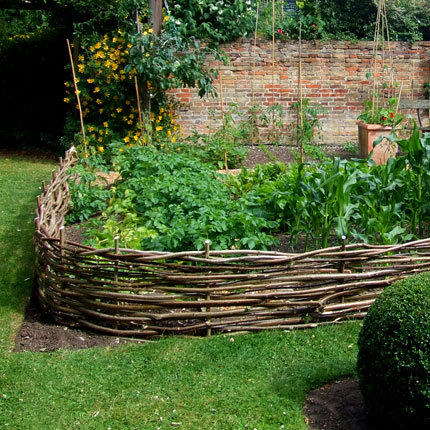
Wattle raised beds

Rubber tire gardens

Hugelkultur

An herb spiral
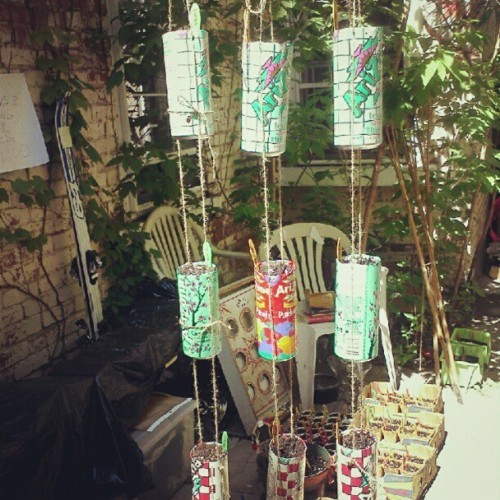
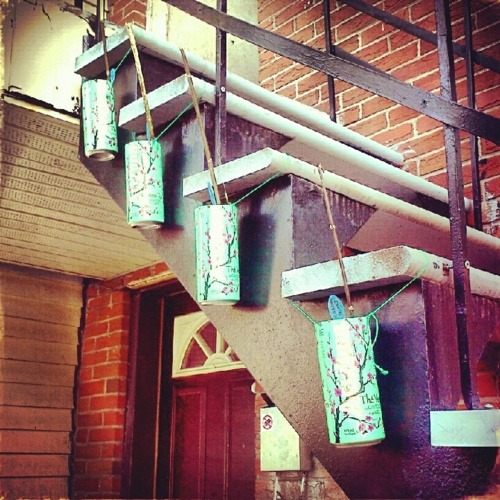
Hanging gardens in cans (2)
Trellises and supports
Many plants need external support, such as stakes of trellises, to thrive.
Rebar can almost always be salvaged cheaply or free and makes a great trellis, arch, or purgola
Build trellises and supports out of the pliable young stems of plants like willow
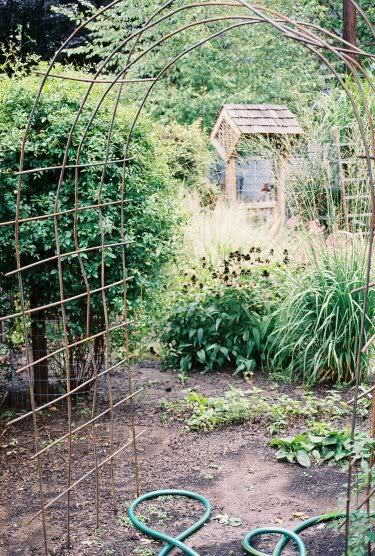
Rebar trellis/arch

Living willow arch/trellis
Paving
Paving often requires a foundation of sand or another stable and well-drained substrate, and a covering of stones, bricks, or other weatherproof elements. Slowly collect stones over time, or free paving stone fragments to create a mosaic-type walkway. Often people give these things away on craigslist. I made a patio and fireplace out of free salvaged bricks, for example.

Salvaged garden walkway
Greenhouses and cold frames
Here is a gallery of greenhouses made out of salvaged windows and doors
A cold frame is easy to make with salvaged lumber, and plastic sheeting.
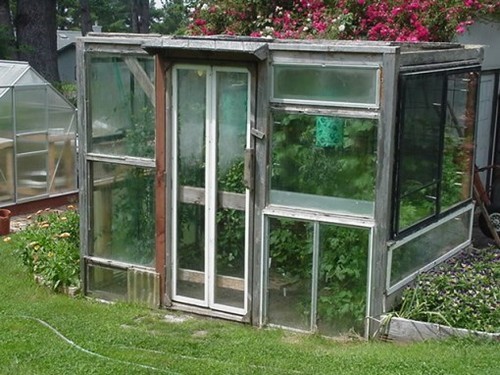
Window greenhouse
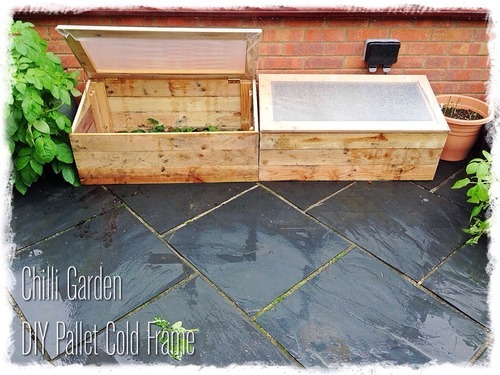
Palet cold-frame
Seeds and plants
Swap seeds with other gardeners
If you see a plant you like at someone’s house, ask for seeds or cuttings
Save seeds every year and build a library of options. Here is a great guide to seed saving.
Save seeds from foods you like from the grocery store: consider growing peanuts, ginger, garlic, peppers, or a walnut tree: all of these and more can be planted from store-bought produce.
Learn to take cuttings. There is a tonne of info on the web about basic cutting propagation, layering, (like I do with rhododendrons) air layering, and numerous other techniques to take clones of plants you like. This saves going to a nursery and shelling out big bucks for all the variety you want.
For cuttings, willow tea and honey are great rooting hormones/antiseptics/anti-fungal agents, which can save you $40 if you were thinking of buying commercial rooting hormone.
You can root cuttings in a potato! (See my methods for rooting “borrowed” plants here)
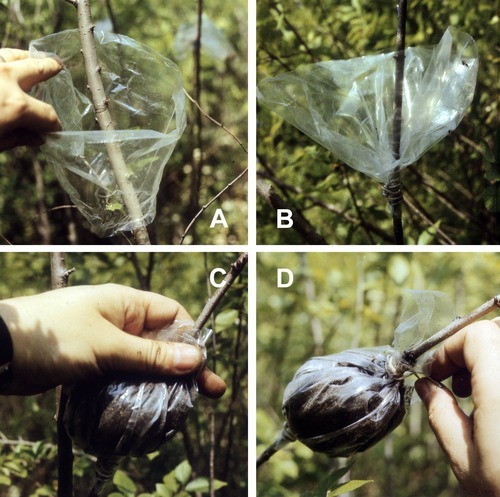
Air layering
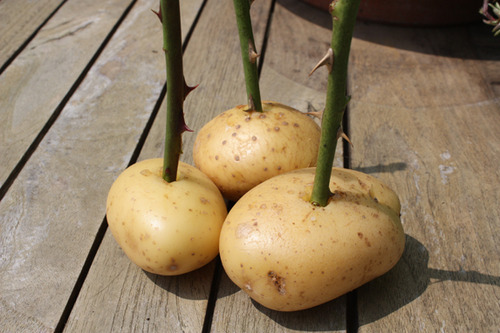
Rooting cuttings in potatoes
—-
I hope this helps you build your garden outside of the usual capitalist channels! It can be a cheap or free hobby if you are willing to think outside the box, and maybe put up with things that don’t look as clean or crisp as a hardware store catalogue. If you have any further ideas, please add them! The more information the better.
-
 techrefs reblogged this · 3 weeks ago
techrefs reblogged this · 3 weeks ago -
 geneticallymodifiedidiot liked this · 3 weeks ago
geneticallymodifiedidiot liked this · 3 weeks ago -
 somanytoremember liked this · 3 weeks ago
somanytoremember liked this · 3 weeks ago -
 steppentime reblogged this · 3 weeks ago
steppentime reblogged this · 3 weeks ago -
 steppentime liked this · 3 weeks ago
steppentime liked this · 3 weeks ago -
 bumblebeeappletree reblogged this · 3 weeks ago
bumblebeeappletree reblogged this · 3 weeks ago -
 bumblebeeappletree reblogged this · 3 weeks ago
bumblebeeappletree reblogged this · 3 weeks ago -
 albi-bumblebee liked this · 3 weeks ago
albi-bumblebee liked this · 3 weeks ago -
 ember-of-the-three-braincells reblogged this · 3 weeks ago
ember-of-the-three-braincells reblogged this · 3 weeks ago -
 bumblebeeappletree reblogged this · 3 weeks ago
bumblebeeappletree reblogged this · 3 weeks ago -
 thetemperancecard reblogged this · 1 month ago
thetemperancecard reblogged this · 1 month ago -
 kngtrshmouth66 reblogged this · 1 month ago
kngtrshmouth66 reblogged this · 1 month ago -
 bumblebeeappletree reblogged this · 1 month ago
bumblebeeappletree reblogged this · 1 month ago -
 bumblebeeappletree reblogged this · 1 month ago
bumblebeeappletree reblogged this · 1 month ago -
 idrinkfrombuckets reblogged this · 3 months ago
idrinkfrombuckets reblogged this · 3 months ago -
 undeadobscurities reblogged this · 1 year ago
undeadobscurities reblogged this · 1 year ago -
 solhaelan liked this · 1 year ago
solhaelan liked this · 1 year ago -
 ffionfables liked this · 1 year ago
ffionfables liked this · 1 year ago -
 carpenterenbee reblogged this · 1 year ago
carpenterenbee reblogged this · 1 year ago -
 carpenterenbee liked this · 1 year ago
carpenterenbee liked this · 1 year ago -
 maybe-a-cat42 reblogged this · 1 year ago
maybe-a-cat42 reblogged this · 1 year ago -
 friendlyneighborhoodbb reblogged this · 1 year ago
friendlyneighborhoodbb reblogged this · 1 year ago -
 friendlyneighborhoodbb liked this · 1 year ago
friendlyneighborhoodbb liked this · 1 year ago -
 emintoomanyfandoms liked this · 1 year ago
emintoomanyfandoms liked this · 1 year ago -
 emintoomanyfandoms reblogged this · 1 year ago
emintoomanyfandoms reblogged this · 1 year ago -
 lazlolullaby reblogged this · 1 year ago
lazlolullaby reblogged this · 1 year ago -
 okbutwhy-rebooted reblogged this · 1 year ago
okbutwhy-rebooted reblogged this · 1 year ago -
 equivocate-em liked this · 1 year ago
equivocate-em liked this · 1 year ago -
 which-star liked this · 1 year ago
which-star liked this · 1 year ago -
 spaghettti-cat reblogged this · 1 year ago
spaghettti-cat reblogged this · 1 year ago -
 spaghettti-cat liked this · 1 year ago
spaghettti-cat liked this · 1 year ago -
 abbinurmel reblogged this · 1 year ago
abbinurmel reblogged this · 1 year ago -
 galactic-bi-cat liked this · 1 year ago
galactic-bi-cat liked this · 1 year ago -
 onehalfoftheset reblogged this · 1 year ago
onehalfoftheset reblogged this · 1 year ago -
 songbirdpyka liked this · 1 year ago
songbirdpyka liked this · 1 year ago -
 carmen-sandal-eggos reblogged this · 1 year ago
carmen-sandal-eggos reblogged this · 1 year ago -
 carmen-sandal-eggos liked this · 1 year ago
carmen-sandal-eggos liked this · 1 year ago -
 itsdappleagain reblogged this · 1 year ago
itsdappleagain reblogged this · 1 year ago -
 itsdappleagain liked this · 1 year ago
itsdappleagain liked this · 1 year ago -
 myqueenmarceline liked this · 1 year ago
myqueenmarceline liked this · 1 year ago -
 crazywolf828 reblogged this · 1 year ago
crazywolf828 reblogged this · 1 year ago -
 souliebird reblogged this · 1 year ago
souliebird reblogged this · 1 year ago -
 tittypocalypse reblogged this · 1 year ago
tittypocalypse reblogged this · 1 year ago -
 januarygracemorgan reblogged this · 1 year ago
januarygracemorgan reblogged this · 1 year ago -
 truemacabrekidbutoldlike liked this · 1 year ago
truemacabrekidbutoldlike liked this · 1 year ago -
 onsie liked this · 1 year ago
onsie liked this · 1 year ago